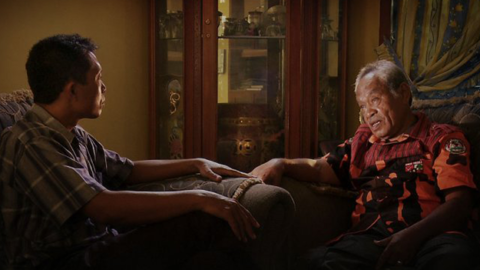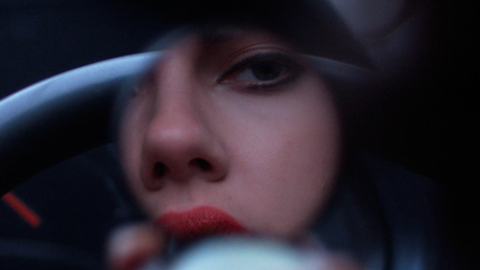Festivals: Telluride

Viva
Cuban actor Hector Medina arrived a day late to the Telluride Film Festival over the weekend. Airline snafus hampered the already complicated itinerary that would take him to Colorado, so landing late meant that he’d miss the world premiere of Viva, the new film starring the twenty-something newcomer. Unfazed, Medina had his debut at an event in progress buoyed by the immediate buzz generated from that first small screening on the eve of his arrival. By the time Medina hit the fest on its second day an extra showing of the movie had already been added to meet increased demand. More TBA screenings were booked all weekend as word spread that Viva was a Telluride discovery, the event’s unlikely underdog.
Set in Havana’s queer community, Viva, directed by Irish filmmaker Paddy Breathnach, follows young Jesus (Medina), a teen aiming to embrace life as a drag performer at the club where he styles its seasoned performers. Looked after by a surrogate parent he calls Mama (Luis Alberto Garcia), Jesus reconnects with his estranged father at the club but is quickly shunned over his burgeoning queer lifestyle.
The sentimental template for Viva‘s queer coming-of-age story may well be rather familiar, particularly as the young boy musters the strength to be himself, winning over audiences as he finds his voice. Yet the story’s unique setting—an increasingly open Cuba that has yet to fully come to terms with its past persecution of LGBT citizens—adds a quiet layer of complexity to the Irish-Cuban co-production. Performances of classic songs by Latin drag queens add flashes of camp, melodrama, and fantasy to the film, which charmed Telluride moviegoers all weekend.
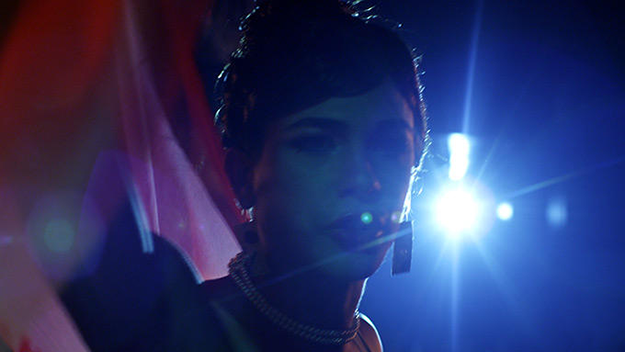
Viva
Medina’s best friend back home is a local drag performer who guided him while the emerging actor was rehearsing the part. Medina said that he was particularly focused on gestures and lip syncing that would add authenticity to his performance.
“For me, really, the essence of my performance came from being in touch with the emotions of the character,” Medina explained in Spanish on Monday during the Labor Day picnic that caps the weekend festival. The actor said he connected with trans and drag Cubans who faced problems with their own families. “It was very emotional,” Medina added. “I had to tame the melodrama, but being on stage was very liberating.”
In the wake of the Telluride debut, the filmmakers are now considering invitations and offers, and they also hope to screen the movie in Cuba where Mariela Castro, daughter of the country’s President, is leading a change in policies and attitudes towards queer Cubans.
While Viva arrived here with little awareness—the festival’s lineup customarily isn’t announced until the day before it begins—and as a result unknown films can face an uphill battle against mainstream festival fare, other new films on the roster sparked immediate interest. Of those, Danny Boyle’s Steve Jobs and Sarah Gavron’s Suffragette were noteworthy. While Gavron’s latest takes a traditional approach to exploring the suffragette movement in Britain, Boyle’s portrait of the icon Apple founder is unconventional.
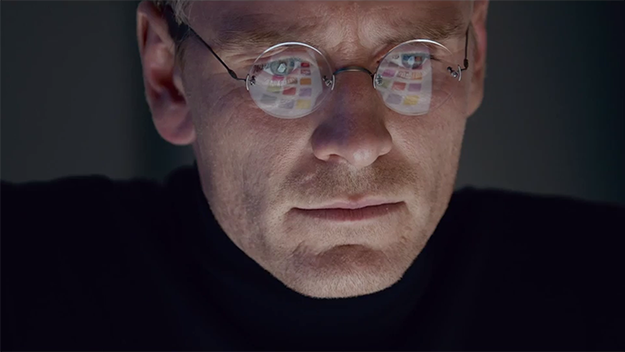
Steve Jobs
Danny Boyle’s slick film unfolds primarily through three long scenes, each about 40 minutes long and set just before one of Apple’s key product launches. Steve Jobs paints a picture of its title character (played by Michael Fassbender) through his relationships with a few key people in his life (his young daughter, her distraught mother, a company advisor, former Apple exec John Scully and also co-founder Steve Wozniak). Walking and talking quickly in trademark Sorkin style, each character confronts Jobs privately in the frenetic minutes before he takes the stage in front of his adoring fans. Flashbacks during these long scenes recall key moments in Jobs’s personal and professional life.
“Much of it is imagined,” writer Aaron Sorkin explained at an outdoor panel discussion, saying that the backstage conversations were meant to portray his subject more broadly. In the film, he has infused these scenes with historical information and character insights drawn loosely from Walter Isaacson’s biography of the infamously mercurial former Apple chief. Yet as Sorkin explained over the weekend, he strayed considerably from the original source material after it was handed over to him by producer Scott Rudin.
“What I didn’t want to do was a straight up biopic about Steve Jobs,” Sorkin, who spent a year researching and then another year writing the film, added during an outdoor festival panel discussion. “I also didn’t want it to be a piece of journalism.”
“Art isn’t about what happened, it’s not a photograph,” Sorkin related. “It’s a painting.”
His remarks in Telluride came on a weekend when a new documentary about Steve Jobs opened in select movie theaters and on iTunes. Sorkin said that viewers should look to Alex Gibney’s documentary Steve Jobs: The Man in the Machine, for insights about the Apple leader.
“You can see a very good piece of journalism about this subject,” he said, referencing the Gibney film. “This is a painting.”
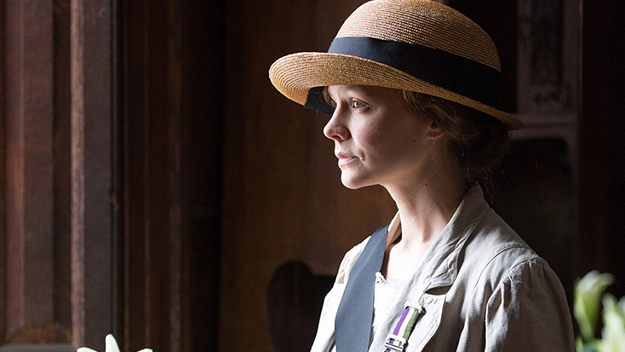
Suffragette
While not journalistic, British director Sarah Gavron’s look at the fight for women’s voting rights in her own country is a more traditional biopic that hews closely to the docudrama approach seen in last year’s Selma. It captures the groundwork laid by what Gavron, introducing Suffragette this weekend, called “the foot soldiers of the movement.”
“It’s taken 100 years for this story to get to the screen,” the British filmmaker said before the screening. “I’ve wanted to make it for 10 years.”
Depicting the increasingly aggressive acts of civil disobedience and violence that marked the movement as it gained strength in England, Gavron’s serious-minded film chronicles the initial achievement of voting rights for some women in 1918 and then full voting rights within 10 years. A Telluride regular best known for 2007’s Brick Lane and the recent documentary Village at the End of the World, Gavron employs sweeping music and a broad canvas in telling its true story.
For many moviegoers, an early cinematic memory of the British suffragette movement on screen is the Sister Suffragette number from Disney’s Mary Poppins in 1964. In that film, matron of the house Mrs. Banks is seen marching through her living room to enlist support for the cause from her staff. At a small after-party for the film’s Telluride debut, Meryl Streep reflected on how depictions of the movement have vastly improved in 50 years.
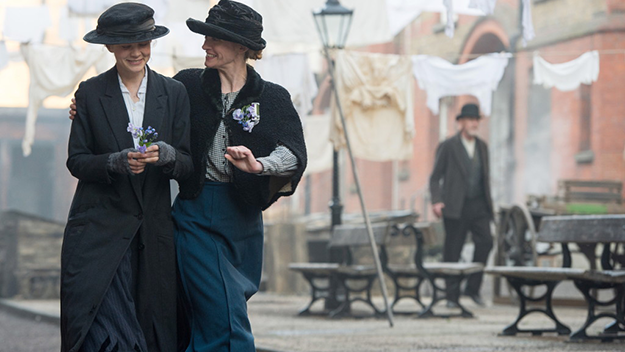
Suffragette
Streep recalled that the Mary Poppins sketch seemed rather dismissive of the civil-rights fight, playing it for laughs and looking down on the activist. In Suffragette, Streep plays Emmeline Pankhurst, leader of the British movement, and Gavron, standing next to her at the reception, said that without Streep, the movie simply could not have been made. The actress has only one scene in the film, a rousing speech to rally her troops for battle, but it was clear to both Gavron and Streep that a movie of this scale about this subject wouldn’t get funded without such a bold-faced name in place.
Throughout the weekend, Streep spoke out for international women’s rights and championed the film ahead of other upcoming festival appearances before it opens in theaters.
“I think that women of that generation felt that lack—they had it built into them. They felt lesser than, and it’s a very difficult thing to dislodge from your mind once it’s placed there,” Streep explained during a public conversation about Suffragette here. “And the people who shake it off and realize that we are all human beings and equal—it doesn’t mean you all have the same upper body strength, because there isn’t a man in this audience who could out-lift Serena Williams.”
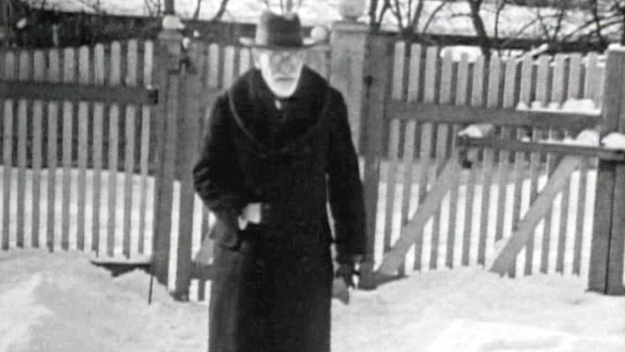
The Century of the Self
While the suffragette movement was being fought in Britain, stateside the movement was met with a twist thanks to a nephew of Sigmund Freud. In The Century of the Self, the 2002 TV documentary series by this year’s Telluride tribute honoree Adam Curtis, the British director opens his four-hour program—screened this year again in its entirety—with an examination of Edward Bernays, long considered the father of public relations and an early mass-media propaganda specialist.
In the 1920s, Bernays was enlisted to help market cigarettes to women, and he embarked on a campaign to recast them as “torches of freedom” that evoke the Statue of Liberty’s lamp. Up until that time it was socially unacceptable for women to smoke in public, so Bernays sought to tap into the move for independence among young women. After a PR stunt at New York City’s Easter Parade, cigarette sales to women spiked. Curtis detailed the incident as an early example of how American sentiment was altered to support consumer goals.
As in his 2004 series, The Power of Nightmares, and the recent staging of his collaboration with Massive Attack at the Park Avenue Armory in New York, Curtis finds links and connections between institutions and elusive figures in often unexpected places. Yet the sort of well-heeled tastemakers who attend an event like Telluride are not Adam Curtis’s target audience, he explained in an interview published in the festival’s printed publication.
“I’m interested in reaching other people than the sort of people who go to film festivals,” Curtis told Telluride’s FilmWatch.
Curtis’s new film, Bitter Lake, screened at the festival during a tribute program dedicated to the iconoclastic director. While he relented and allowed it to show in a movie theater in Telluride, Curtis said that the movie, which probes the complex relationship between Afghanistan and Western governments, was instead made for the Internet. He’s fine with people stopping and starting it, watching at their own pace on a computer screen. The festival screened The Century of the Self on the big screen at a makeshift movie theater at the local library but also broadcast his work via a local public-access TV channel in town.
“I’m not interested in cinema,” Curtis said in FilmWatch, labeling himself a journalist rather than a filmmaker. “I’ve never been interested in cinema at all.”
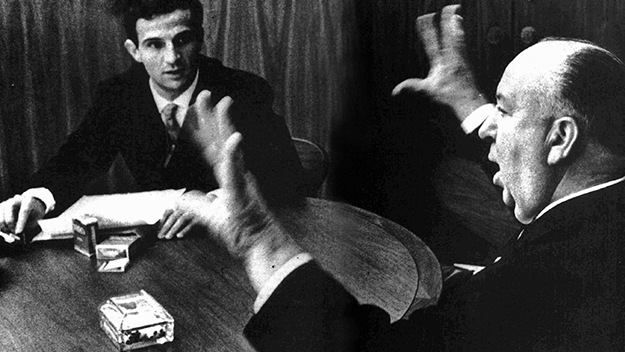
Hitchcock/Truffaut
Conversely, Hitchcock/Truffaut, the new documentary by Kent Jones, Jason Silverman’s Sembene!, and Laurie Anderson’s Heart of a Dog were aimed squarely at Telluride’s core audience.
In Hitchcock/Truffaut, the pages of the French auteur’s 1967 book about his conversations with the iconic American filmmaker come alive. Through interviews with directors including David Fincher, Wes Anderson, Martin Scorsese, and others, Jones (Director of the New York Film Festival, an editor at FILM COMMENT, and a staffer at the magazine’s publisher, The Film Society of Lincoln Center) examines Hitchcock’s oeuvre. Audio excerpts of the legendary conversations between the two directors and photos from their sessions illuminate the insights alongside clips from numerous Hitchcock films.
Director James Gray, also interviewed for the film, told Jones that the new film is “cinephile porn.” In Telluride, attendees were openly engaging with it (and also asking Jones how they might see more).
Commenting on the origin of the project at one of the screenings, Jones recalled, “I got a call from the producer of this film asking if I wanted to make a film about Hitchcock and Truffaut. And I said, fuck yeah!”
For Sembene!, Jason Silverman (an annual staffer at the Colorado event) joined forces with Samba Gadjigo to explore the life and work of African filmmaker Ousmane Sembene, the father of that continent’s cinema. The new film features extensive clips from his decades of work, follows him to places like the Film Society of Lincoln Center in New York and other festivals, and also includes insights from those who know his work and knew him.
“Sembene’s genius is to value black lives,” theater director Peter Sellars noted in introducing the film’s first screening here, emphasizing the unique value in experiencing the cinema through African eyes, an experience not seen before Sembene’s rise to prominence.
“If Africans do not tell their own stories,” Sembene noted in the film, “Africa will soon disappear.”

Heart of a Dog
Finally, the other documentary that had attendees buzzing all weekend was artist Laurie Anderson’s personal portrait of life, love and loss, Heart of a Dog.
Narrated by Anderson, the film shares home movies from her childhood and links them to footage she has been collecting since just after 9/11, including plenty of material starring Lolabelle, the dog that she raised with her late husband Lou Reed. Who knew that Reed and Anderson’s pet pooch had been trained to play the piano and even released a Christmas album?
“It’s a film mostly about love and death but also about stories,” Anderson said slowly, speaking with a smile during the entire Q&A following the film’s final indoor screening. The following night organizers presented an outdoor showing in a local park with the caveat that attendees should bring their dogs to the show.
Anderson admitted that the movie, which follows the death of her dog and also obliquely references the loss of her husband, inadvertently became an expression of her philosophy of life.
Asked about the presence of Lou Reed in her movie—he plays a doctor in one dream sequence—she said at the Q&A: “His spirit is all around this movie and I dedicated it to him.”
Lou Reed was “an extremely fierce person,” Laurie Anderson concluded. “His spirit of fierceness was always inspiring to me.”



